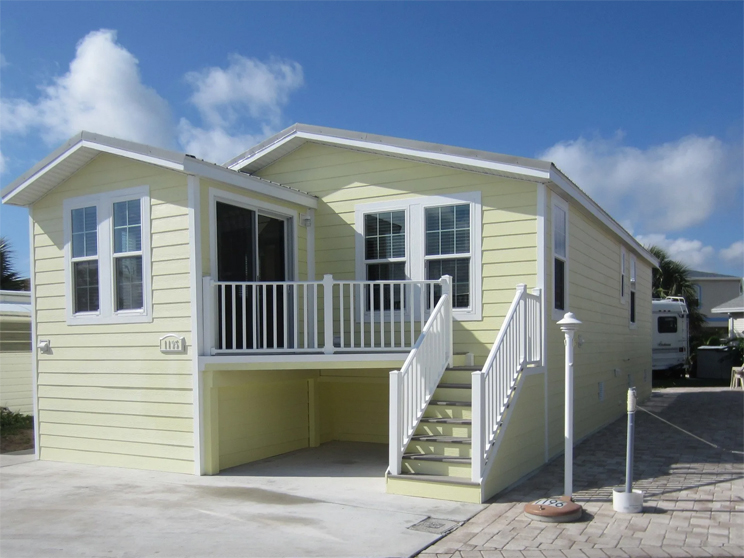Picture this: You’re comparing two factory-built homes. One is newly constructed—engineered for energy efficiency, built to today’s rigorous safety codes, and ready to withstand Florida’s toughest weather. The other, a decades-old mobile home, shows its age with outdated materials and minimal storm resistance.
They may share a name in conversation, but they don’t share the same standards.
In today’s housing market, modular and manufactured homes are often unfairly grouped with mobile and prefab homes—even though the differences in construction, safety, and value couldn’t be more pronounced. If you’re researching your next home, understanding this divide is essential.
Here’s why modular and manufactured homes aren’t just better, they’re in a category of their own.
Modular and Manufactured Homes: Characteristics and Considerations
When you want long-term value and peace of mind, modular and manufactured homes are the clear front-runners in the factory-built housing space. These homes combine affordability with exceptional quality and flexibility, giving you real control over your investment.
Modular homes are constructed in factory sections, then assembled on a permanent foundation. They meet the same rigorous state and local building codes as site-built homes, making them a strong contender for those seeking a permanent residence that blends efficiency with traditional comfort.
Manufactured homes, meanwhile, are engineered under the U.S, Department of Housing and Urban Development (HUD) code, a federal building standard focused on energy efficiency, structural integrity, and safety. Built in controlled environments and inspected throughout every phase, these homes offer outstanding value for families, retirees, and first-time buyers alike.
At Jacobsen Homes, we elevate both styles with thoughtful customization, from spacious modular homes floor plans to energy-smart features that make our luxury modular homes feel like a true personal retreat.
Mobile and Prefab Homes: Key Features and What to Consider
Mobile and prefab homes may come with appealing price tags and catchy marketing, but don’t let the surface fool you. These housing types often lack the durability, regulatory oversight, and design integrity that today’s homebuyers expect, and deserve.
Mobile homes, built prior to 1976, are not subject to current HUD standards. That means outdated materials, questionable construction, and limited protections against hazards like hurricanes or extreme heat—something Florida homeowners simply can’t afford to risk.
Prefab homes are a mixed bag. The term can refer to anything from modular to kit-built structures, but many prefab builds lack a consistent standard. Even some of the best prefab homes don’t meet the structural benchmarks required for long-term housing, and trendy design often overshadows essential quality.
So if you’re thinking about buying a mobile home or comparing modern prefab homes online, keep in mind: these homes often cut corners where it matters most.
Construction Standards: Comparing the Building Processes of Each Home Type
When comparing modular vs prefab homes, the biggest differentiator is how—and to what standard—they’re built.
The construction process of modular homes gives them a clear edge. These homes are constructed in factory-controlled environments, then assembled on-site to meet the same codes as traditional housing. Likewise, manufactured home construction follows a rigorous process under federal HUD guidelines, ensuring that every component is safe, efficient, and ready to withstand real-world conditions.
Mobile and prefab homes, by contrast, often face limited oversight or rely on outdated standards that fall short of what modern homebuyers should accept.
Evaluating Your Options: A Balanced Comparison of the Four Home Types
It’s easy to get caught up comparing surface-level features or initial price tags, but here’s how things stack up when you look at the big picture:
Modular and Manufactured Homes:
- Code-compliant construction for safety and peace of mind
- Custom layouts and finishes that suit your lifestyle
- Energy-efficient materials and lower utility costs
- Built to last—ideal for long-term living
Mobile and Prefab Homes:
- Often built to older or vague standards
- Limited design flexibility
- Higher maintenance over time
- Poorer storm resistance and resale value
While you may wonder about the cost of manufactured homes compared to their prefab or mobile counterparts, the long-term savings in maintenance, energy use, and property value make modular and manufactured homes the clear winner.
Jacobsen Homes: Built for Life in Florida
With over 65 years of experience, Jacobsen Homes is Florida’s leader in manufactured and modular homes. We blend engineering precision with design flexibility to deliver homes that meet the unique demands of Florida’s climate and your lifestyle.
Whether you’re considering a luxury mobile home alternative or weighing modular homes vs mobile homes, we’re here to guide you through every step of the process—from design consultation to move-in day.
Ready to invest in a home that truly delivers?
Contact Jacobsen Homes to explore our wide range of floor plans and discover why Florida families trust us with their dreams.
And if you’re just starting your research, check out our modular and manufactured home offerings to see the difference for yourself.

